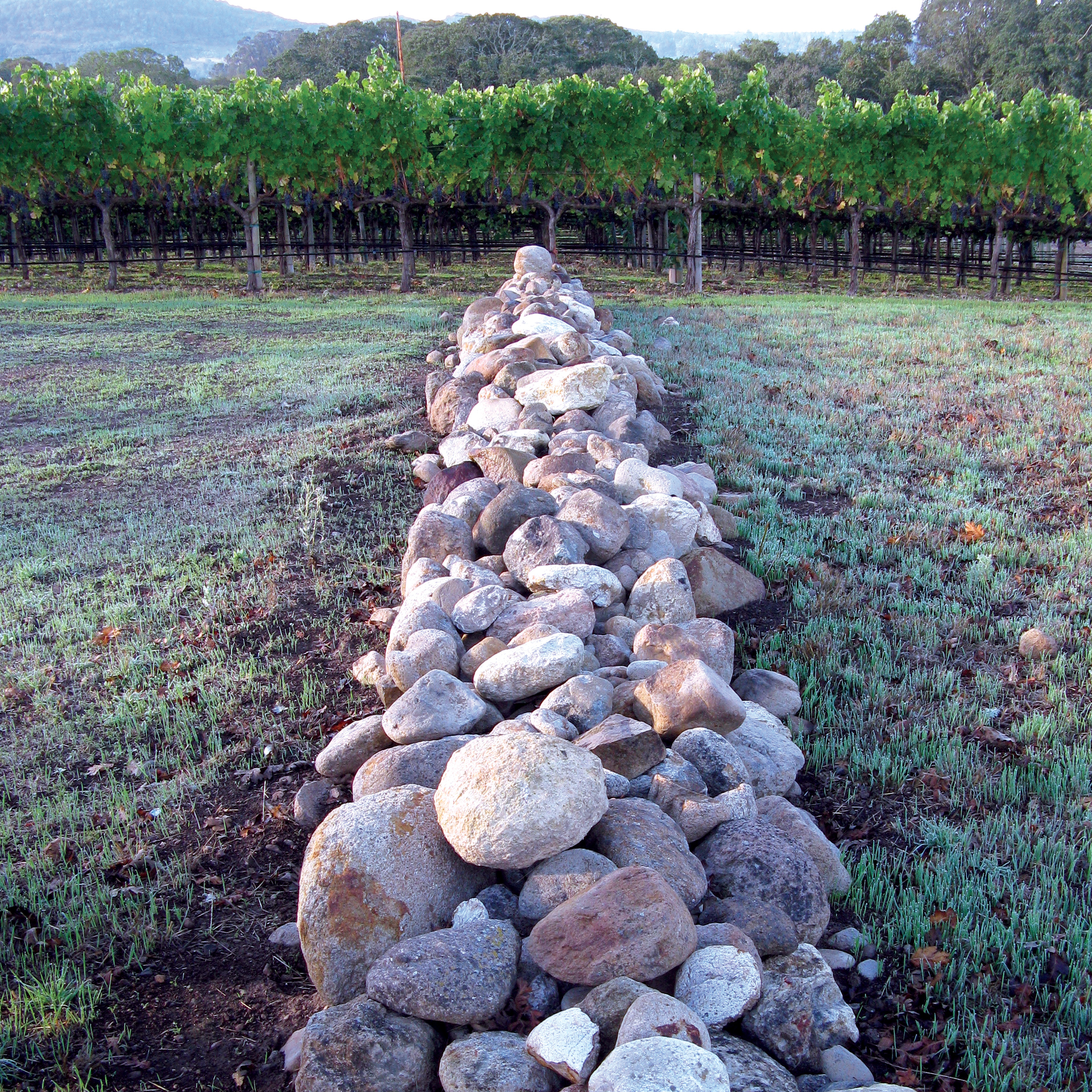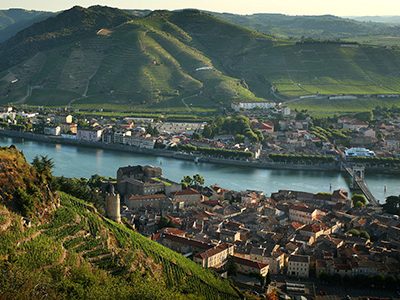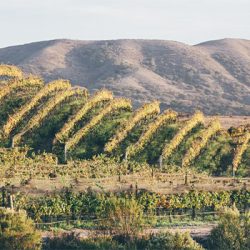For the first two days I toured Coombsville, an out of the way appellation-to-be just east of the town of Napa, I didn’t see the sun. I didn’t see the hills for which it is known, or the extinct volcano, Mt. George, which is usually visible from just about every vineyard parcel in the area. I couldn’t see the bay that’s said to influence the climate dramatically, or, really, much of the vineyards. I saw fog mainly, a moody backdrop to the Tulocay Cemetery, dripping from the oaks and Spanish moss, the fragrant bay laurel and madrone, giving the whole place a gothic, gloomy feel. If Tim Burton had a notion to plant cabernet, this might be the place where he’d do it.
Tucked behind neighborhoods on the city’s east side, mostly within the city limits, Coombsville begins where the city ends, well south of the more famous “up-valley” destinations. This, too, is cabernet country, but it’s nothing like the rest of cabernet country. When marine incursion layers snake into the Napa Valley from the San Pablo Bay, they arrive here first and leave here last, resulting in one of the valley’s longest growing seasons. “We’re definitely in the later part of normal,” says Annie Favia, who makes Favia wines with her husband, Andy Erickson, winemaker for Dalla Valle, among other up-valley brands. Favia adds, “It’s the one place in the valley we don’t have to worry about heat spikes.” So it’s gloom all right, but gloom with benefits: Coombsville is probably the coolest cab-producing region in the Napa Valley. Which means that balance at lower alcohol, if you want it, is there for the taking.
Coombsville is poised to become Napa’s newest appellation. Having just completed the application process, its fate now rests with the TTB, but its passage seems all but certain: geographically few Napa regions are more distinctive, or easier to delineate. Most Coombsville vineyards are set within a horseshoe-shaped ring of hills rising east of town, bordered on its northern flank by Mt. George, the 1,900-foot inactive volcano whose past activities are in evidence everywhere you look. The ridge curls east, then south, then west, in the uniform curve of a volcano’s maw. In fact, volcanologists believe that the formation is a caldera, a crater formed when a portion of volcanic uplift collapses, leaving, in this case, a weathered curvilinear ridgeline.
“We’re definitely in the later part of normal,” says Annie Favia, who makes Favia wines with her husband, Andy Erickson, winemaker for Dalla Valle, among other up-valley brands.
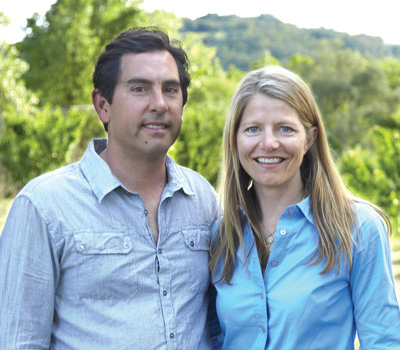

But the caldera theory doesn’t fully account for what’s found in the middle of the horseshoe. Geologist Jonathan Swinchatt, who with David G. Howell has written about the Coombsville formation in his book The Winemaker’s Dance, suggests that “it’s a caldera modified by large landslide activity.” In his book Swinchatt describes how thick folds of earth slid down into the cavity, leaving graceful, hummocky hills bunched up against one another and then further altered by erosion.
Almost all of the soils in the region are some combination of two components: accumulated landslide debris bearing a reddish brown hue, something Swinchatt calls colluvium; and layers of light, flaky volcanic ash, from Mt. George’s eruptions. The area’s roadcuts reveal ash deposits laying over one another in thick strata, each delineated by its subtle shadings—beige, ecru, seashell, sandy gray. While there are likely similar deposits in other parts of the Napa Valley, Coombsville’s formation is large and discrete; nearly every vineyard in the region has ash as its bedrock.
Those two components are a critical element in the personality of the cabernet grown here, says Ken Bernards, who makes wines at two Coombsville wineries, Tournesol and Porter Family. At Tournesol, where the soils contain as much as 90 percent colluvium deposits, he finds that the cabernet is spicier and more structured than at Porter Family; he’ll typically pick up a bright elevated red fruit note, as well as a violet florality. At Porter Family, where ash deposits dominate the soil makeup, he gets cabernet with more black fruit elements, and lifted mid-palate textures, a grip of tannins that’s fine and sleek, more silk cord than hemp rope.
Most of what is now Coombsville fell under two portions of a Vallejo land grant, one bestowed to Cayetano Juarez in October of 1841, which he called Rancho Tulocay (the name given to Napa’s oldest cemetery, too). A second grant was given to José Higuera; a portion of Higuera’s stake was purchased in 1847 by Nathan Coombs, who established a farm he called “Willows,” and used the rest of his parcel to found the city of Napa the following year on land adjacent the river. (The proposed AVA will in fact extend to the river in downtown Napa; the Oxbow Public Market and the former Copia are within its boundaries).
Coombs was a religious man—he donated several parcels of land for churches in Napa City—and was believed to be a teetotaler. But vineyards soon appeared on hillsides east of town. That is where Henry Hagen planted grapes for his winery, Cedar Knoll, now on the Palmaz property.
It didn’t survive Prohibition, but Bill Moore’s “Earthquake” vineyard did: An august, head-trained zinfandel vineyard on Hagen Road, it was planted just before the San Francisco earthquake in 1905 and has been used in recent years by both Robert Biale and Turley. Haynes Vineyard, planted in 1966, is the oldest modern vineyard in the region, primarily chardonnay and pinot noir. Bill Cadman at Tulocay, Coombsville’s oldest winery, has been buying fruit from Duncan Haynes since a handshake deal brought them together in 1975.
The following year, Frank Farella established Coombsville’s first modern plantings of cabernet, 26 acres on mostly west-facing slopes on a rise not far from Mt. George. Today it is managed by his son Tom, who in addition to selling fruit to many Napa wineries, was the first to make a 100 percent Coombsville cabernet in 1991. Farella’s wines remain a benchmark for the region; they bear that firm, ’90s-era structure and balance; they feel cool and reserved compared with up-valley cabs.
Farella’s plantings were followed in 1982 by vines at Caldwell Vineyard, which sits on a dramatic hillside near the southern ridgeline. On a recent afternoon, just as the interminable cloud cover was breaking up, John Caldwell pulled up outside of his cave on an ATV and beckoned me to hop on; we took a tour of his vineyards, stopping once at a roadcut where the meeting point of ash and colluvium is clearly visible about six feet below the vineyard surface. From there we puttered to the highest point on the property, where we met his father, Jack, now 90; they’ve worked together here for nearly 30 years. Caldwell put it in ‘park’ and I stood up on my rear seat. From there I could take in nearly every vine in Coombsville, not to mention sweeping views of Napa Valley’s northern reaches, all the way to Mt. St. Helena.
Caldwell had made a modest fortune selling clogs in the ’70s; he purchased land east of Napa at the end of that decade, thinking he might develop housing there, but by 1982, he’d decided to plant grapes instead, roping his father into the enterprise. Soon they’d established Sunridge Nursery, planting and propagating varieties he’d received from the French government, including cabernet clone 337 (known now as 1337), a floral, high-toned iteration that has turned out to be especially expressive in Coombsville (the team at Meteor Vineyard planted 337 in part because of its success at Caldwell).
Caldwell never doubted that cabernet would do well—“It’s easy to make good wine here,” he says—he just didn’t know how distinctive it would be. There is the color, for starters: The long growing season extends the potential for flavor and color maturity longer than many up-valley locales, as sugars remain manageable, pHs low. And there is, Caldwell maintains, a “softness” to the cabernet tannins. “They have this brightness,” says Caldwell, “they’ve had that from the first year we made wines here. They sparkle.”
Over the years Caldwell’s fruit has attracted several up-valley winemakers, including Joseph Phelps, Randy Dunn and Jason Pahlmeyer, who was the first to designate the vineyard on his label. Caldwell also attracted the interest of Philippe Melka, who became his winemaker from 1997 to 2007. (Marbue Marke makes the wines today.)
Other growers like Richard Perry, Richard Bennett, and the Sciandri Family followed suit. Coombsville cabernet developed a reputation for its structure, backbone and its trace notes of herbs. Soon it was being snatched up by up-valley producers like Robert Mondavi, Opus One, Rombauer, Merryvale, Far Niente and others (of established up-valley wineries, only Silverado Vineyards owns extensive tracts in the region; Quintessa’s Faust project is also based there). “It’s phenologically distinct from St. Helena, Rutherford or Oakville,” says Damian Parker of Joseph Phelps Vineyards, who used Caldwell fruit for years in the Insignia blend. “The sugars don’t run in front of the flavors.”
For years, however, few outside of Farella-Park and Caldwell bottled 100 percent Coombsville cabernet. But two high profile projects brought some attention back to the area, both debuting with regional bottlings.
In 1994 Argentine physician Julio Palmaz and his wife Amalia, with a healthy collection of Bordeaux as their aesthetic guide, went looking for cooler climate vineyard land in the valley to plant Bordelais varieties. They fell in love with the old Hagen winery, Cedar Knoll, where they unearthed old bottles, label stamps and winemaking equipment. Palmaz, who invented the first heart stent, bored a wine cave into caldera rock and developed vineyards on the surrounding property, close to the wilds of Mt. George and its chaparral. In fact, the family has planted the highest (and driest) vineyards in the area, at 1,200 and 1,400 feet, and put out reds that balance the region’s high-toned notes with up-valley polish.
If Coombsville has an epicenter, it’s Meteor Vineyards, established in 1999 by former AOL Chairman and CEO Barry Schuler. His love of Napa cabernet began in the early ’80s, when he first tasted Heitz Martha’s Vineyard. “I wanted to find Martha,” he says, “I wanted to hunt her down.” When he started to consider buying property here, down-valley wasn’t the usual choice for a high-profile tech mogul, but it was convenient: Schuler could still commute to the Silicon Valley, tending to various venture capital projects, and be near his and his wife Tracy’s progressive education project in Napa, called the Blue Oak School. But mostly, he says, the challenge appealed to him. “I really liked the fact that Coombsville was still undiscovered,” he says, “It rang my entrepreneurial bell.”
He found a 22-acre knoll with a direct line of sight to, well, nearly everything around it—the bay, the valley, Mt. George—and began planting. It turned out that the soils here are unique, even for Coombsville: In addition to the colluvium and tuff mélange, Meteor’s soils have a high proportion of cobble in the mix. No one is quite sure where this cobble comes from, but the landslide activity may have pushed it there, the way glaciers push debris from one place to another. The drainage that cobble affords the soil, in addition to the air drainage down this west-facing slope and the prominent exposure at the top of the knoll all combine to set this site apart. This may, in fact, be Coombsville’s cru.
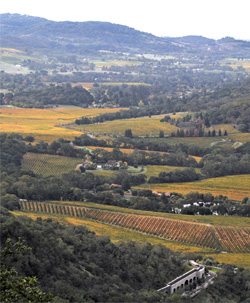

Schuler employs Dawnine and Bill Dyer to make two wines, both cabernets, Perseid and Special Family Reserve. The latter wine is made in tiny quantities with a single clone (7), the power clone, yielding a dense wine. The Perseid employs clones 3, 7, and 337, and in its youth the 2008 makes the best of the mix, with clones 3 and 7 providing the bass for the high-toned spiciness of 337. The Perseid, in particular, leaves the impression of grace and lift like few Napa cabernets do, Coombsville’s cool climate expressing itself in the wine.
Meteor is also the source for the Favia Napa Valley Cabernet. Annie Favia, a vineyard specialist who spent a decade working with David Abreu, convinced her husband, Andy Erickson, that Coombsville was the place to set up their own label. It’s a different direction for Erickson, the winemaker for Dalla Valle, Ovid, Dancing Hares and Arietta, with past stints at Screaming Eagle, Staglin, and Harlan. According to Favia, “We wanted to find a place where the wines come together on their own, where we could make them and not do anything to them.” The wine they make from Meteor is hardly shy, but it is aromatically delicate, suave in the mouth and laced with a charging minerality that Favia refers to as a “mudstone” quality—her word for the tuff’s lingering palate impression.
Minerality tends to dominate the flavor impression in Coombsville cabernet fruit. I took to calling it “blood iron” in my tasting notes, the scent of blood, the feel and flavor of iron, rust, ferrous stones in the texture. There is often a finely wrought spiciness, like orange pekoe tea laced with cinnamon. With such dark colors you expect dark fruit, but the wines’ acidity always brings a brightness, a red character.
The wines frequently possess just the slightest hint of violets or evergreen, an element common to cabernet but that many growers, in recent years, have sought to eliminate by maturing the fruit past peak ripeness. In Coombsville you can get past it, but such efforts feel unwieldy and pushed, a much harder prospect here than in the rest of the valley, since the average daily temperature is at least seven to ten degrees cooler than in St. Helena.
So there remains a modest minty note, subtly lining the palate flavors like the first wisps of fog in the evening. It feels natural here, an inevitable and inescapable terroir element. In fact Coombsville may well be one of those places where such accents can be reclaimed in American cabernet. In the Napa Valley, where going big is frequently a choice, a bit of forced moderation feels like an antidote to excess.
This story appears in the print issue
of December 2011.
Like what you read? Subscribe
today.

